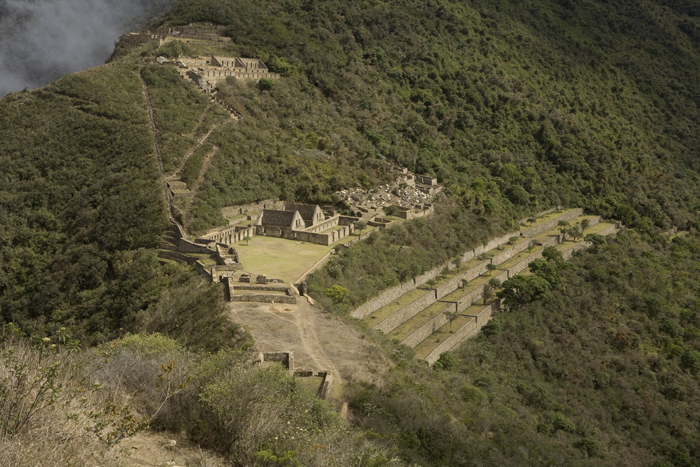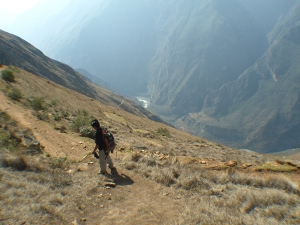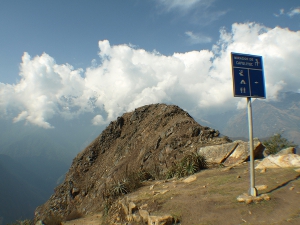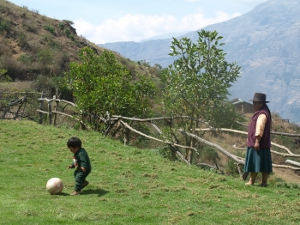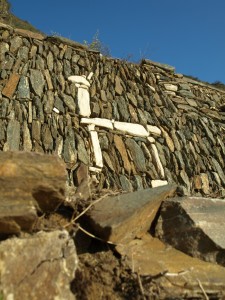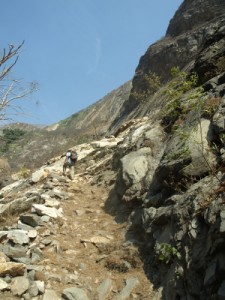Choquequirao Trail
Location: Southern mountains of Peru
Date of trek: September, 2011
Duration/total distance: four days/64 kilometres
STORY AND PHOTOS BY DUSTIN WALKER
I step lightly, just in case the ancient stones beneath my feet shift and send me tumbling toward the jungle brush below.
Terraces carved from the mountainside resemble rows of massive stairs. In the distance, a waterfall cascades behind a barren temple where hundreds of citizens once prayed in the dying days of the Inca Empire.
My wife, Shawneen, and I trek deeper into the ruins. Ferns and patches of dark moss spill from cracks in the rock walls. The air is thick and earthy. We finally reach our local guide, who is staring hard across the landscape of relics and tangled forest. He keeps quiet, as if trying to pick up on some tiny sound hidden in the valley. Then a smile creases his young face.
“We’re the only the ones here,” he says. “No one else around.”
***
This solitude, this silence, is part of what makes the ancient city of Choquequirao so extraordinary. The archeological site, located in the mountains of south Peru, matches the size of world-famous Machu Picchu and also shares similarities in architecture and planning. But unlike the country’s most popular Incan attraction, you can’t ride a tour bus here. Those who want to reach Choquequirao must travel 64 kilometres of punishing trails that take hikers up and down two mountains.
The rugged terrain means only a handful of visitors seek this sprawling complex of aqueducts, temples, houses and mausoleums. According to the Tourist Observatory in Peru, only about 7,600 people ventured to Choquequirao in 2010. That’s only 1% of the visitors that gawked at Machu Picchu the same year.
Those numbers add up to an ideal trip for crowd-weary travellers. Shawneen and I share a natural aversion to people-packed locales. We’ll still squeeze our way past herds of tourists to take in amazing sights like Machu Picchu, but we’re far more comfortable exploring on our own. We wanted an experience that led us away from nattering tour groups and we were willing to pay in sweat and sore muscles to get it. Over the last decade, more travellers have sought out Choquequirao for the exact same reasons.
The Peruvian government is examining ways to funnel additional tourists into this lesser-known archeological gem, including the possible construction of a cable car to carry people up to the site. The Choquequirao Trail is also changing as local families build lodges and campgrounds for tourists. However, travellers can still explore this ancient city before it hits mainstream tour books, if they move fast.
Not just another tourist town
Our trek begins in the farming village of Cachora, located about a three-hour drive from the City of Cusco. We gear up at the home of Carlos Augusto Robles Ocampo, a local resident who started a tour company – simply named Choquequirao Trail Tour Operator – about five years ago. Shawneen and I will be travelling with our guide Samuel Quispe, who has made a living guiding trekkers for the past three years.
We’ll also be joined by Cachora natives Jesus and Louis, who have been contracted to help set up camp, cook and drive the trio of mules that will haul our supplies for the next four days. Carlos’ elderly mother and father come out to shake our hands and bid us farewell before we step onto the cobblestone road to start the journey.
Unlike tourist-clogged Aguas Calientes, the town closest to Machu Picchu, Cachora shows no signs of an emerging tourism industry. No gift shops or restaurants line these streets; instead, women in bright-coloured tunics peel potatoes outside mudstone houses. Men leading pack mules nod to us as we pass by. A school bell blares, not quite drowning out the laughter of children.
I wonder if the simple life enjoyed in Cachora might one day be threatened if Choquequirao becomes more popular. But Samuel isn’t concerned about that. More tourists means more business for villagers who rent pack mules or sell supplies in the community of about 200 people. However, he is worried that fewer travellers will make the trek if a cable car to Choquequirao is built.
“When the trail gets more tourists, it’s good for everyone,” said the slight-framed 26-year-old, who is rarely without a smile.
We leave the village and continue along a path that stretches across fields of potatoes and agave. Turquoise eucalyptus trees dot mountains that crowd the sky. Farmers still comprise much of the traffic along this route. Trains of mules hauling supplies in and out of the steep valleys kick up clouds of yellow dust as they pass.
The trail hugs sharp cliffs that tower above the roaring Apurimac River. Snow-capped tips of the Salkantay mountain ridge pierce the blue skyline. We eventually stomp our way to the Capuliyoc viewpoint. The entire valley opens to us from this spot, but milky clouds obscure our view of the distant ridge where Choquequirao awaits.
We rest and admire the scenery; Samuel watches the sky. About five years ago, condors could still be seen soaring above us, he explains. But as the trail became busier, the massive birds became almost impossible to spot in this area.
We stomp down a series of sheer switchbacks that drop more than 1,200 metres toward the Apurimac River. Hungry sandflies swarm our legs, undeterred by layers of DEET.
We are surprised to discover a washroom and cold showers at our first campground at Chikisca. The government has helped many of the farming families that live along the trail build such amenities. It’s hoped that this will draw in more tourists, diverting traffic off the busy Inca Trail and helping boost the local economy.
The thrill of being alone
We start hiking early the next morning to avoid the September heat. After crossing a bridge over the crashing river, the most difficult part of the trek beings: a 1,500 vertical-metre march up steep switchbacks.
Shawneen and I are seasoned backpackers, comfortable tromping along the remote trails of Canada’s west coast. But this terrain is far different than anything we traversed back home. The altitude, reaching more than 3,000 metres above sea level, and dry, hot conditions leave us panting and soaked in sweat.
After pushing up the final stretch of path, a scattering of mud brick buildings comes into view. This is Marampata, home to eight families who grow corn and fruit in the land surrounding the trail.
We walk past fences made of thin, twisted branches before Samuel invites us to sit outside an adobe hut. Chickens scurry across the grass; a pig squeals from somewhere in the bushes. Luisa Fransisca Ccayhuri, who owns the property, watches over her toddler grandson as he chases a rooster. Luisa moved to Marampata from Cachora a decade ago, in search of a better life for her eight children. She told us this has been the busiest year yet for visitors, which means more income selling sodas and renting camping spots on her property.
The rest and food energize us and we quicken our pace. Soon, the dirt trail is replaced by a stone path. Cold wind hits us as we emerge onto a plaza filled with faded grass. Jagged peaks toss shadows across stone buildings and the remnants of a rock wall that twists along the edge of a cliff. For now, we’re the only ones at Choquequirao and the emptiness is oddly thrilling.
A ceremonial hill, completely flat at its summit, rises above a small temple to our left. Only the most important spiritual leaders would have been allowed to walk through the archway and climb to the ring of stones at the height of the bluff. Priests meditated and sacrificed llamas to the Gods from this spot.
Gary Ziegler, an American archaeologist who worked on the first excavation of Choquequirao, believes the city was a spiritual retreat; a place for pilgrimages and ceremonies involving leaders of the Inca Empire.
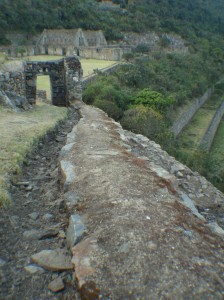
Only the mos important spiritual leaders would have been allowed to pass through this archway at Choquequirao.
Across the plaza are apartments that once housed important citizens, such as military captains or high priests. We hike past these structures, just as another group of trekkers wanders into the area.
The second level of the city features shells of temples and mausoleums. Nearby, a young man digs away at the jungle growth that creeps towards the foundation of a shrine. He tells us that normally only a handful of people arrive at Choquequirao each day, but this year averaged a surprising 50 visitors during the busy months between May and September. That’s still a fraction of the 500 trekkers that hike the less-gruelling Inca Trail daily.
The worker says archeologists had just found two previously uncovered houses deep within the jungle. Major excavations at Choquequirao didn’t begin until 1993. Although the main buildings are cleared of brush, at least 25% of the city is still overgrown.
We backtrack to the plaza and then descend a long set of steps on the opposite side of the ridge. Walls built into the hillside feature life-sized depictions of llamas arranged with white quartzite stone. Ziegler believes this is a monument to the animals, which were relied on for sacrifices and hauling produce out of the community.
We climb back to the plaza as the sun slips behind the mountains. We hike the last few kilometres to our campsite in darkness.
‘Not everyone can make it’
The next morning, we head to the farming terraces located in the jungle valley, several kilometres away from the main Choquequirao site. These structures contort the earth into narrow, cube-shaped strips that stretch across the hillside. Farmers grew crops of corn and coca here to support a population that was likely larger than the 700 people that lived at Machu Picchu.
Crumbling houses cling to steep cliffs; a temple stands out against a waterfall that weaves through the forest. We clamour up and down stone steps for more than two hours without seeing another person.All too soon, our small heads back to the main trail, leaving the ruins of Choquequirao behind us. As we retrace our steps, I wonder how long this place will remain in relative obscurity. It won’t stay off the mainstream tourist’s map forever, but could it really become the next Machu Picchu?
I mull over this question as we reach the river and start hiking back up rows of switchbacks. The afternoon sun is blazing now and the climb offers little shade; just rock cliffs and powder-like dirt that sticks to sweaty skin.
Samuel suddenly quickens his pace up the mountain: three children, no more than 12, sit among the rocks. One round-faced girl is sobbing, her eyes shut tight. She collapsed from heat exhaustion a few moments ago. We try our best to shield her from the relentless sun and give the children water. Each of them gulp heavily from our Nalgene bottles.
They’re students from one of the surrounding villages, on a school trip to Choquequirao. Samuel doesn’t come right out and say it, but the sombre look on his face tells me he’s not impressed that the kids are hiking such a tough trail unprepared.
The teachers soon arrive and thank us for our help. They assure us the group will rest at the next camp right away.
We continue uphill again, the anguished look of that girl’s face still fresh in my mind.
“Not everyone can make it to Choquequirao,” Samuel later remarks as we rest at the Capuliyoc viewpoint.
We all nod in agreement and prepare to hike the last few kilometres back to Cachora.Before we leave, Samuel surveys the distant mountain ridge; a final look, perhaps, on the off-chance he catches a glimpse of the condors that could once be seen soaring through these skies.
Getting there:
Once travellers arrive in Lima, they can choose from a variety of domestic carriers to get to the City of Cusco, such as TACA or Star Peru. Flights take about one hour. It’s recommended that you book at least a month in advance if travelling to this city during the peak tourism season (June to September).
Once in Cusco, travellers will need to make their way to Cachora, where the Choquequirao Trail begins. This can be an adventure in itself. Most tour companies will pick you up at your hostel or hotel and drive you to the village. If going solo, you can hire a taxi to take you there for a surprisingly reasonable fare.
This article originally appeared in Adventure Travel magazine.
Do you prefer the trails less travelled?
Join like-minded trekkers by signing up for the S&TT e-mail list. Every week, you’ll get:
- Profiles of little-known hiking destinations
- Gear reviews for backpackers and hikers
- Feature articles on strange and off-beat hiking
Plus we’re 100% spam-free (and proud of it)

